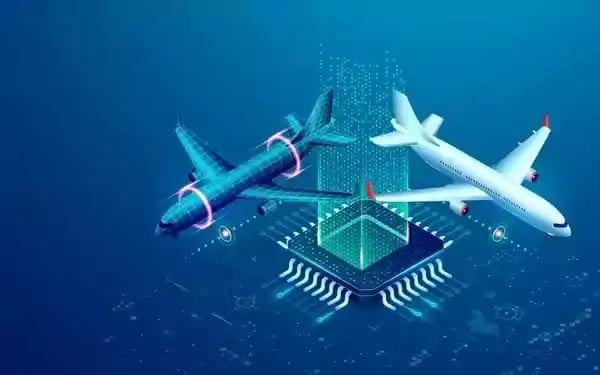What are the seven main functionalities that aviation maintenance software should have?
At QOCO Systems we work with over 40+ leading airlines, MROs and OEM's and are constantly made aware of to the latest issues within the software environment, needs, bottlenecks. In the last 15 years we have gathered data and built our systems as either standalone or integrated into existing M&E systems such as AMOS. Now we want to share what we consider key functionalities of aircraft maintenance software.
The different maintenance management software solutions, e.g., M&E systems, in aviation, are essential for managing the complex processes of maintenance, repair, and overhaul (MRO) activities. These software solutions are helping airlines and MROs improve operational efficiency, comply with regulations and ensure safety, ultimately leading to efficient and standardized operations. However, and unfortunately, many operations still suffer from legacy and manual input in their operations.
This article shows the main features of aircraft maintenance management software. It explains how these tools make maintenance better and keep planes safe to fly. For more comprehensive insights, be sure to read “Everything you need to know about MRO software”.
If you'd like to read more articles about MRO software, take a look at these:
- Gains for MRO from digital solutions
- Synchronising MRO software with airline ERP platforms
- 5 Things You Need to Look for in MRO Software

1. Comprehensive Maintenance Scheduling and Planning
Efficient scheduling is fundamental to maintaining regulatory compliance, ensuring operational readiness, and minimizing disruptions. Maintenance software simplifies this process by automating scheduling tasks and providing real-time visibility into upcoming and ongoing activities.
Core Capabilities:
- Automated Scheduling: Generates maintenance schedules based on flight hours, cycles, and calendar intervals, ensuring tasks are planned well in advance.
- Conflict Resolution: Identifies and resolves scheduling conflicts between planned maintenance tasks and operational requirements, reducing the risk of delays.
- Resource Coordination: Allocates personnel, tools, and hangar space efficiently to ensure seamless operations.
One standout feature in modern scheduling solutions is the ability to automate work package allocation and staff planning, simplifying what has traditionally been a labor-intensive process. By integrating directly with current Maintenance & Engineering (M&E) systems, advanced tools like QOCO Assignment ensure real-time updates and precise resource distribution. See the QOCO Assignment webinar with a demo of its features.
These features help reduce workload by automating repetitive tasks and enabling planners to focus on strategic decisions. Shifts of maintenance technicians and resources can be balanced effortlessly, minimizing inefficiencies and overlapping schedules. With capabilities like these, airlines and MROs can transform their scheduling processes, boosting productivity while maintaining compliance with industry standards. But most importantly, and especially in a time where the industry is struggling with resource shortages, good and efficient software can make a huge difference.
2. Work Order Management
Work orders are the backbone of maintenance operations. Effective management ensures that all tasks are completed efficiently, documented correctly, and meet regulatory standards.
Core Capabilities:
- Dynamic Assignment: Allocates tasks based on technician qualifications and availability.
- Progress Tracking: Provides real-time updates to supervisors and stakeholders.
- Digital Signatures: Captures approvals electronically to streamline workflows.
American Airlines has taken work order management to the next level by implementing natural language processing (NLP) to improve maintenance efficiencies. One key application of NLP involves speech recognition for maintenance documentation.
Imagine a mechanic equipped with a tablet in a noisy hangar environment. Instead of manually entering data, the mechanic can describe maintenance findings or actions verbally, and the system transcribes this input into a digital format automatically. While this sounds simple, it involves significant challenges, as the mechanic’s environment often includes background noise and specialized terminology.

As noted by Tassio Carvalho, former American Airlines’ Managing Director of Maintenance Operations Systems, pre-trained language models from companies like Microsoft and Google must be customized for aviation-specific vocabulary and mechanics’ unique language patterns. Despite these hurdles, this innovation promises to:
- Save time by reducing manual data entry.
- Minimize errors in documentation.
- Provide immediate access to detailed, transcribed maintenance records for supervisors and planners.
By integrating technologies like NLP into real-time work order management, airlines and MROs can significantly enhance their operational efficiency, ensuring tasks are performed and recorded seamlessly even in challenging environments.
3. Streamlined Inventory and Material Management
The availability of spare parts directly impacts maintenance timelines. Maintenance software optimizes inventory management, reducing costs while ensuring critical components are always on hand.
Core Capabilities:
- Real-Time Tracking: Monitors inventory levels across multiple locations.
- Automated Procurement: Triggers reorder processes for low-stock items.
- Compatibility Checks: Ensures parts align with aircraft configurations.
Asia Digital Engineering (ADE), a Malaysian aviation services firm, has experienced rapid growth in aircraft repairs due to a shortage of new planes. Given the persistent supply chain challenges in the aviation industry, Asia Digital Engineering (ADE) has taken a proactive and innovative approach to tackle inventory management with its proprietary online platform, AeroTrade. Developed entirely in-house by ADE’s technical engineers, AeroTrade started as a solution for selling excess spare parts to generate cash for the company’s growth.
Initially, ADE listed surplus inventory and reached out to third-party airlines with a straightforward value proposition: "You need spares, we need cash." This mutually beneficial arrangement quickly gained traction. As the platform evolved, ADE integrated an algorithm to verify parts certification, ensuring reliability and compliance for buyers.

-
4. Compliance and Regulatory Adherence Records Management
Aviation regulations demand strict compliance, requiring operators to maintain detailed records and implement airworthiness directives (ADs) and service bulletins (SBs) promptly. Maintenance software automates these processes, emphasizing the importance of storing digital records for streamlined operations and future readiness.
Core Capabilities:
- Compliance Tracking: Monitors adherence to ADs, SBs, and local aviation regulations.
- Audit Readiness: Maintains digital logs for easy access during inspections, ensuring records are always available and organized.
- Documentation Management: Centralizes records for all maintenance activities, supporting the transition to a fully digital aviation ecosystem.
- Quality Assurance: Automates quality checks and inspection tasks, tracks non-conformance issues, and ensures corrective actions are implemented.
Platforms like Lufthansa Technik's AVIATAR further enhance compliance management by offering real-time monitoring of regulatory requirements and seamless integration with existing maintenance systems. AVIATAR's advanced analytics and digital tools ensure that the records are tracked and executed efficiently, providing operators with a centralized hub for documentation and audit readiness. As the aviation industry continues to embrace digitization, tools like these will help aviation operators become more efficient and compliant.

-
5. Fleet and Configuration Management
Managing diverse fleets requires real-time insights into each aircraft’s configuration, maintenance history, and performance metrics. Software centralizes this data for better decision-making.
Core Capabilities:
- Configuration Control: Tracks component installations, part numbers, and approved modifications.
- Fleet Health Monitoring: Displays key performance metrics, including fuel efficiency and engine performance.
- Long-Term Trend Analysis: Identifies recurring issues and informs future maintenance strategies.
JetBlue Airways implemented a modern maintenance management system to better manage its fleet and deal with aircraft out-of-service events. This system has opened many doors for better fleet maintenance management, improving operational efficiency.

-
6. Predictive Maintenance with Data Analytics
Predictive maintenance uses historical and real-time data to forecast when components are likely to fail, enabling proactive repairs. This reduces unscheduled downtime and optimizes maintenance costs.
Core Capabilities:
- IoT Integration: Collects live data from aircraft sensors for real-time analysis.
- Failure Forecasting: Predicts maintenance needs based on usage patterns and performance trends.
- Cost Optimization: Minimizes unnecessary maintenance tasks and parts usage.
Aviadex, QOCO’s Data Exchange and Integration Service, revolutionizes the way aviation industry operators collaborate and manage data. By enabling intelligent data exchange across the industry, Aviadex addresses a critical challenge faced by many operators: the reliance on outdated methods of manual data sharing or complex point-to-point integrations.
Through its data exchange ecosystem, QOCO Aviadex allows collaborators to integrate once and seamlessly share selected data with the appropriate parties. For operators engaged in predictive maintenance, this streamlined data exchange eliminates the delays, human errors, and inefficiencies associated with manual processes.
-
7. Tool and Equipment Management
Specialized tools are essential for efficient and accurate aircraft maintenance. Maintenance software not only tracks tool usage but also ensures their availability, proper calibration, and timely return, helping organizations avoid delays and maintain compliance with safety standards.
Core Capabilities:
- Tool Check-In/Out: Tracks tool assignments and availability in real time, ensuring technicians always have access to the tools they need.
- Calibration Management: Alerts users when tools require recalibration or servicing, reducing the risk of using non-compliant or inaccurate equipment.
- Misplacement Alerts: Prevents losses by notifying staff of overdue or misplaced tools, ensuring tools are always accounted for.
QOCO MROTools takes tools and equipment tracking a step further, addressing common pain points in tooling management. Designed specifically for the aviation industry, MROTools simplifies the process of booking, returning, and tracking tools needed for aircraft maintenance and repairs.
With over 1 million tooling transactions, QOCO MROTools has gained deep insights into tooling challenges and solutions. By eliminating bottlenecks, the platform helps organizations:
- Streamline tool availability and reduce downtime.
- Improve resource utilization across maintenance operations.
- Enhance overall efficiency, ensuring smooth operations for both routine and complex maintenance tasks.
Conclusion: The Future of Aircraft Maintenance Management
Advanced aircraft maintenance software is transforming MRO efficiency by integrating capabilities like predictive maintenance, automated compliance tracking, and precise tool management. For airlines and MROs, this means less AOG time, streamlined fleet health monitoring, and real-time oversight of maintenance scheduling and inventory.
The gains for MRO from digital solutions are clear: we can achieve enhanced dispatch reliability, reduce operational bottlenecks, and improve regulatory compliance, all while ensuring safety remains uncompromised. As we face tighter margins and increasing demand, investing in robust, aviation-specific systems is essential for maintaining fleet readiness, reducing turnaround times, and staying competitive in the aviation industry.
We have the data to show it. Be sure to read our case studies with Lufthansa, Neos, Finnair, Condor and Rolls-Royce to understand the benefits further.



 Jichen Lu
Jichen Lu
 If you are interested in knowing how you can improve your efficiency in maintenance operations, book a 30-minutes discovery call with us.
If you are interested in knowing how you can improve your efficiency in maintenance operations, book a 30-minutes discovery call with us.

